Infrared Light Annealing Effect on Pressure Sensor Fabrication Using Graphene/Polyvinylidene Fluoride Nanocomposite
Abstract
1. Introduction
2. Experimental Procedure
2.1. Preparation of the Gr/PVDF Nanocomposites
2.2. Preparation of the Sensor Test Fixture
3. Results and Discussion
3.1. Characterization of Gr/PVDF Nanocomposite
3.2. Raman Spectroscopy
3.3. Sensor Performance and Testing
3.4. Temperature Effect on Pressure Sensor Sensitivity of Gr/PVDF Nanocomposite
3.5. Temperature Dependence on Electrical Conductivity
3.6. Mechanical Properties of the Gr/PVDF Nanocomposite
3.7. Hysteresis in a Gr/PVDF Nanocomposite
4. Challenges and Future Research Efforts of Gr/PVDF Nanocomposite
5. Conclusions
Author Contributions
Funding
Data Availability Statement
Acknowledgments
Conflicts of Interest
References
- Almassri, A.M.; Hasan, W.Z.W.; Ahmad, S.A.; Ishak, A.J.; Ghazali, A.M.; Talib, D.N.; Wada, C. Pressure Sensor: State of the Art, Design, and Application for Robotic Hand. J. Sens. 2015, 2015, 1–12. [Google Scholar]
- Eaton, W.P.; Smith, J.H. Micromachined pressure sensors: Review and recent developments. Smart Mater. Struct. 1997, 6, 50–539. [Google Scholar]
- Maharjan, S.; Jayatissa, A.H. A Review of Flexible Sensors. In Nanomaterials for Energy and Sensor Applications; CRC Press: Boca Raton, FL, USA, 2022; pp. 137–153. [Google Scholar]
- Xu, F.; Li, X.; Shim, Y.; Li, L.; Wand, W.; He, L. Recent Developments for Flexible Pressure Sensors: A Review. Micromachines 2018, 9, 580. [Google Scholar] [CrossRef] [PubMed]
- Samoei, V.K.; Maharjan, S.; Jayatissa, A.H. Graphene Nanocomposites for Pressure Sensors Applications. In Applications of Nanocomposites; CRC Press: Boca Raton, FL, USA, 2022; pp. 122–137. [Google Scholar]
- Maharjan, S.; Samoei, V.K.; Jayatissa, A.H.; Noh, J.H.; Sano, K. Knittle Pressure Sensor Based on Graphene/Polyvinylidene Fluoride Nanocomposite Coated on Polyester Fabric. Materials 2022, 16, 7087. [Google Scholar]
- Yu, W.; Sisi, L.; Haiyan, Y.; Jie, L. Progress in the functional modification of graphene/graphene oxide: A review. RSC Adv. 2020, 10, 15328. [Google Scholar]
- Xiao, P.; Yi, N.; Zhang, T.; Huang, Y.; Chang, H.; Yang, Y.; Zhou, Y.; Chen, Y. Construction of a fish-like robot based on high-performance graphene/PVDF bimorph actuation materials. Adv. Sci. 2016, 6, 1500438. [Google Scholar]
- Silva, M.; Alves, N.M.; Paiva, M.C. Graphene-polymer nanocomposites for biomedical applications. Polym. Adv. Technol. 2018, 29, 687–700. [Google Scholar]
- Manu, B.R.; Gupta, A.; Jayatissa, A.H. Tribological properties of 2D materials and composites—A review of recent advances. Materials 2021, 14, 1630. [Google Scholar] [CrossRef]
- Lee, S.J.; Yoon, S.J.; Jeon, I.Y. Graphene/Polymer nanocomposites: Preparation, mechanical properties, and application. Polymers 2022, 14, 4733. [Google Scholar] [CrossRef]
- Maharjan, S.; Samoei, V.K.; Jayatissa, A.H. Graphene/PVDF Nanocomposite-Based Accelerometer for Detection of Low Vibrations. Materials 2023, 16, 1586. [Google Scholar] [CrossRef]
- Shuai, C.; Zeng, Z.; Yang, Y.; Qi, F.; Peng, S.; Yang, W.; He, C.; Wang, G.; Qian, G. Graphene oxide assists polyvinylidene fluoride scaffold to reconstruct electrical microenvironment of bone tissue. Mater. Des. 2020, 190, 108564. [Google Scholar]
- Itapu, B.M.; Jayatissa, A.H. A Review in Graphene/Polymer Composites. Chem. Sci. Int. J. 2018, 3, 1–16. [Google Scholar]
- Zheng, X.; Yu, H.; Yue, S.; Xing, R.; Zhang, Q.; Liu, Y.; Zhang, B. Functionalization of graphene and dielectric property relationships in PVDF/graphene nanosheets composites. Int. J. Electrochem. Sci. 2018, 13, 1–13. [Google Scholar]
- Widakdo, J.; Lei, W.-C.; Anawati, A.; Manjunatha, S.T.; Austria, H.F.M.; Setiawan, O.; Huang, T.-H.; Chiao, Y.-H.; Hung, W.-S.; Ho, M.-H. Effects of Co-Solvent-induced self-assembled graphene-PVDF composite film on piezoelectric application. Polymers 2022, 15, 137. [Google Scholar] [CrossRef] [PubMed]
- Huang, T.; Yang, S.; He, P.; Sun, J.; Zhang, S.; Li, D.; Meng, Y.; Zhou, J.; Tang, H.; Liang, J.; et al. Phase-separation-induced PVDF/graphene coating on fabrics toward flexible piezoelectric sensors. ACS Appl. Mater. Interfaces 2018, 10, 30732–30740. [Google Scholar]
- Al-Saygh, A.; Ponnamma, D.; AlMaadeed, M.A.; Vijayan, P.P.; Karim, A.; Hassan, M.K. Flexible pressure sensor based on PVDF nanocomposites containing reduced graphene oxide-titania hybrid nanolayers. Polymers 2017, 9, 33. [Google Scholar] [CrossRef]
- Seraji, S.M.; Jin, X.; Yi, Z.; Feng, C.; Salim, N.V. Ultralight porous poly (vinylidene fluoride)-graphene nanocomposites with compressive sensing properties. Nano Res. 2021, 14, 2620–2629. [Google Scholar]
- Zhang, L.; Zha, D.A.; Du, T.; Mei, S.; Shi, Z.; Jin, Z. Formation of superhydrophobic microspheres of poly (vinylidene fluoride–hexafluoropropylene)/graphene composite via gelation. Langmuir 2011, 27, 8943–8949. [Google Scholar]
- Abzan, N.; Kharaziha, M.; Labbaf, S. Development of three-dimensional piezoelectric polyvinylidene fluoride-graphene oxide scaffold by non-solvent induced phase separation method for nerve tissue engineering. Mater. Des. 2019, 167, 107636. [Google Scholar]
- Cao, Y.; Liang, M.; Liu, Z.; Wu, Y.; Xiong, X.; Li, C.; Wang, X.; Jiang, N.; Yu, J.; Lin, C.-T. Enhanced thermal conductivity for poly (vinylidene fluoride) composites with nano-carbon fillers. RSC Adv. 2016, 6, 68357–68362. [Google Scholar]
- Samoei, V.K.; Jayatissa, A.H.; Sano, K. Flexible Pressure Sensor Based on Carbon Black/PVDF Nanocomposite. Chem. Sci. Int. J. 2024, 33, 1–10. [Google Scholar]
- Maharjan, S.; Samoei, V.K.; Amili, O.; Sano, K.; Honma, H.; Jayatissa, A.H. Design and fabrication of a graphene/polyvinylidene fluoride nanocomposite-based airflow sensor. ACS Omega 2022, 7, 7981–7988. [Google Scholar] [PubMed]
- Cheng, M.; Zhu, G.; Zhang, F.; Tang, W.-L.; Jianping, S.; Yang, J.-Q.; Zhu, L.-Y. A review of flexible force sensors for human health monitoring. J. Adv. Res. 2022, 26, 53–68. [Google Scholar]
- Tai, G.; Wei, D.; Su, M.; Li, P.; Xie, L.; Yang, J. Force-sensitive interface engineering in flexible pressure sensors: A review. Sensors 2022, 22, 2652. [Google Scholar] [CrossRef]
- Mohamadi, S.; Sharifi-Sanjani, N.; Foyouhi, A. Evaluation of graphene nanosheets influence on the physical properties of PVDF/PMMA blend. J. Polym. Res. 2013, 20, 46. [Google Scholar]
- Salam, M.A.E.; Elkomy, G.M.; Osman, H.; Nagy, M.R.; El-Sayed, F. Structure–electrical conductivity of polyvinylidene fluoride/graphite composites. J. Reinf. Plast. Compos. 2012, 31, 1342–1352. [Google Scholar]
- Ahmad, K.; Pan, W.; Shi, S.L. Electrical conductivity, and dielectric properties of multiwalled carbon nanotube and alumina composites. Appl. Phys. Lett. 2006, 13, 89. [Google Scholar]
- Zhang, Y.F.; Zhao, Y.H.; Bai, S.L.; Yuan, X. Numerical simulation of thermal conductivity of graphene filled polymer composites. Compos. Part B Eng. 2016, 106, 324–331. [Google Scholar]
- Zhao, Y.H.; Wu, Z.K.; Bai, S.L. Study on thermal properties of graphene foam/graphene sheets filled polymer composites. Compos. Part A Appl. Sci. Manuf. 2015, 72, 200–206. [Google Scholar]
- Zhang, X.; Yeung, K.K.; Gao, Z.; Li, J.; Sun, H.; Xu, H.; Zhang, K.; Zhang, M.; Chen, Z.; Yuen, M.M.; et al. Exceptional thermal interface properties of a three-dimensional graphene foam. Carbon 2014, 66, 201–209. [Google Scholar]
- Li, A.; Zhang, C.; Zhang, Y.F. Thermal conductivity of graphene-polymer composites: Mechanisms, properties, and applications. Polymers 2017, 9, 437. [Google Scholar] [CrossRef]
- Samoei, V.K.; Maharjan, S.; Sano, K.; Jayatissa, A.H. Effect of Annealing on Graphene/PVDF Nanocomposites. ACS Omega 2023, 8, 13876–13883. [Google Scholar] [PubMed]
- Davaji, B.; Cho, H.D.; Malakoutian, M.; Lee, J.-K.; Panin, G.; Kang, T.W.; Lee, C.H. A patterned single layer graphene resistance temperature sensor. Sci. Rep. 2017, 7, 8811. [Google Scholar]
- Chuang, C.; Woo, T.-P.; Mahjoub, A.M.; Ouchi, T.; Hsu, C.-S.; Chin, C.-P.; Aoki, N.; Lin, L.-H.; Ochiai, Y.; Liang, C.-T. Current Scaling and Dirac Fermion Heating in Multi-Layer Graphene. J. Nanosci. Nanotechnol. 2015, 15, 1195–1198. [Google Scholar]
- Oseli, A.; Aulova, A.; Gergesova, M.; Emri, I. Effect of temperature on mechanical properties of polymers. In Encyclopedia of Continuum Mechanics; Springer: Berlin/Heidelberg, Germany, 2018; pp. 747–766. [Google Scholar]
- Dallaev, R.; Pisarenko, T.; Sobola, D.; Orudzhev, F.; Ramazanov, S.; Trčka, T. Brief review of PVDF properties and applications potential. Polymers 2022, 14, 4793. [Google Scholar] [CrossRef]
- Hsissou, R.; Seghiri, R.; Benzekri, Z.; Hilali, M.; Rafik, M.; Elharfi, A. Polymer composite materials: A comprehensive review. Compos. Struct. 2021, 262, 113640. [Google Scholar]
- Wang, S.; Li, Q. Design, Synthesis and processing of PVDF-based dielectric polymers. Iet Nanodielectrics 2018, 1, 80–91. [Google Scholar]
- Wang, H.; Wu, Y.; Cong, C.; Shang, J.; Yu, T. Hysteresis of electronic transport in graphene transistors. ACS Nano 2010, 4, 7221–7228. [Google Scholar]
- Memarian, F.; Fereidoon, A.; Ganji, M.D. Graphene Young’s modulus: Molecular mechanics and DFT treatments. Superlattices Microstruct. 2015, 85, 348–356. [Google Scholar]
- Mbayachi, V.B.; Ndayiragije, E.; Sammani, T.; Taj, S.; Mbuta, E.R. Graphene synthesis, characterization and its applications: A review. Results Chem. 2021, 3, 100163. [Google Scholar]
- Layek, R.K.; Nandi, A.K. A review on synthesis and properties of polymer functionalized graphene. Polymer 2013, 54, 5087–5103. [Google Scholar]
- Kim, H.S.; Lee, D.W.; Kim, D.H.; Kong, D.S.; Choi, J.; Lee, M.; Murillo, G.; Jung, J.H. Dominant role of Young’s modulus for electric power generation in PVDF–BaTiO3 composite-based piezoelectric nanogenerator. Nanomaterials 2018, 8, 777. [Google Scholar] [CrossRef] [PubMed]
- Wang, W.; Jayatissa, A.H. Computational and experimental study of electrical conductivity of graphene/poly (methyl methacrylate) nanocomposite using Monte Carlo method and percolation theory. Synth. Met. 2015, 204, 141–147. [Google Scholar]
- Wang, W.; Jayatissa, A.H. Comparison study of graphene based conductive nanocomposites using poly (methyl methacrylate) and polypyrrole as matrix materials. J. Mater. Sci. Mater. Electron. 2015, 26, 7780–7783. [Google Scholar]
- Puértolas, J.; García-García, J.; Pascual, F.; González-Domínguez, J.; Martínez, M.; Ansón-Casaos, A. Dielectric behavior and electrical conductivity of PVDF filled with functionalized single-walled carbon nanotubes. Compos. Sci. Technol. 2017, 152, 263–274. [Google Scholar]
- Moldovan, O.; Iñiguez, B.; Deen, M.J.; Marsal, L.F. Graphene electronic sensors–review of recent developments and future challenges. IET Circuits Devices Syst. 2015, 9, 446–453. [Google Scholar]
- Kim, H.; Abdala, A.A.; Macosko, C.W. Graphene/polymer nanocomposites. Macromolecules 2010, 43, 6515–6530. [Google Scholar]
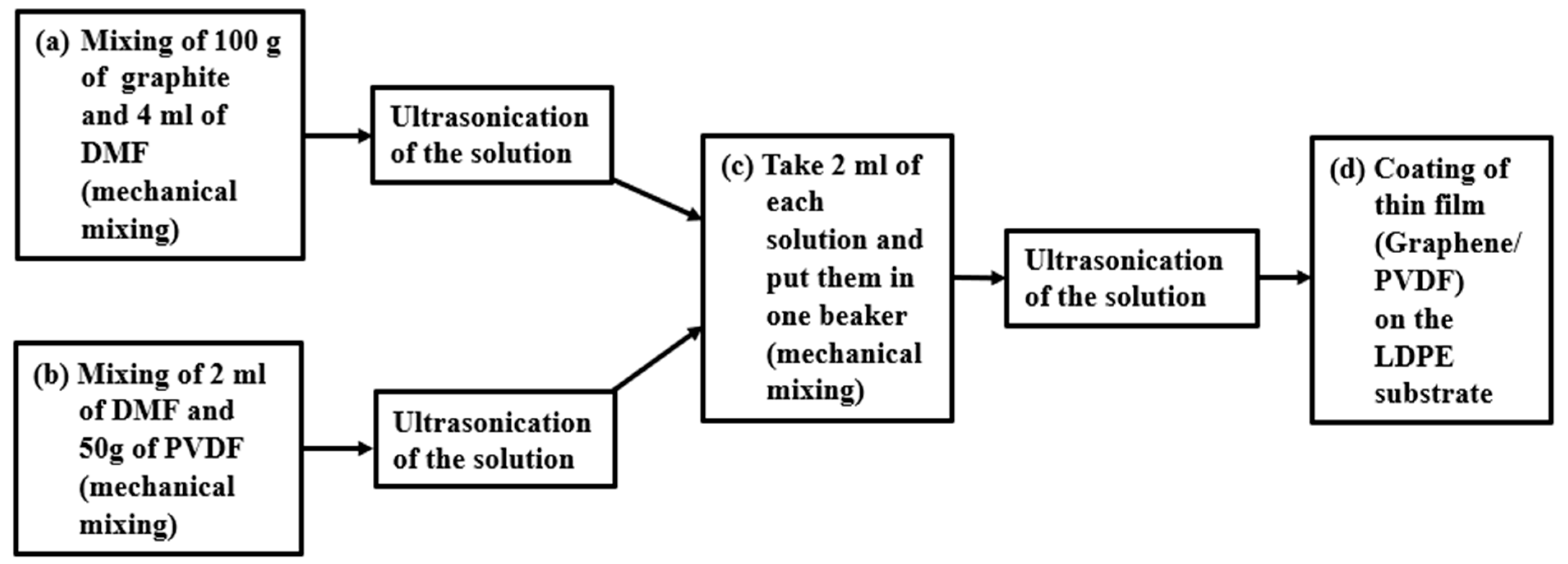
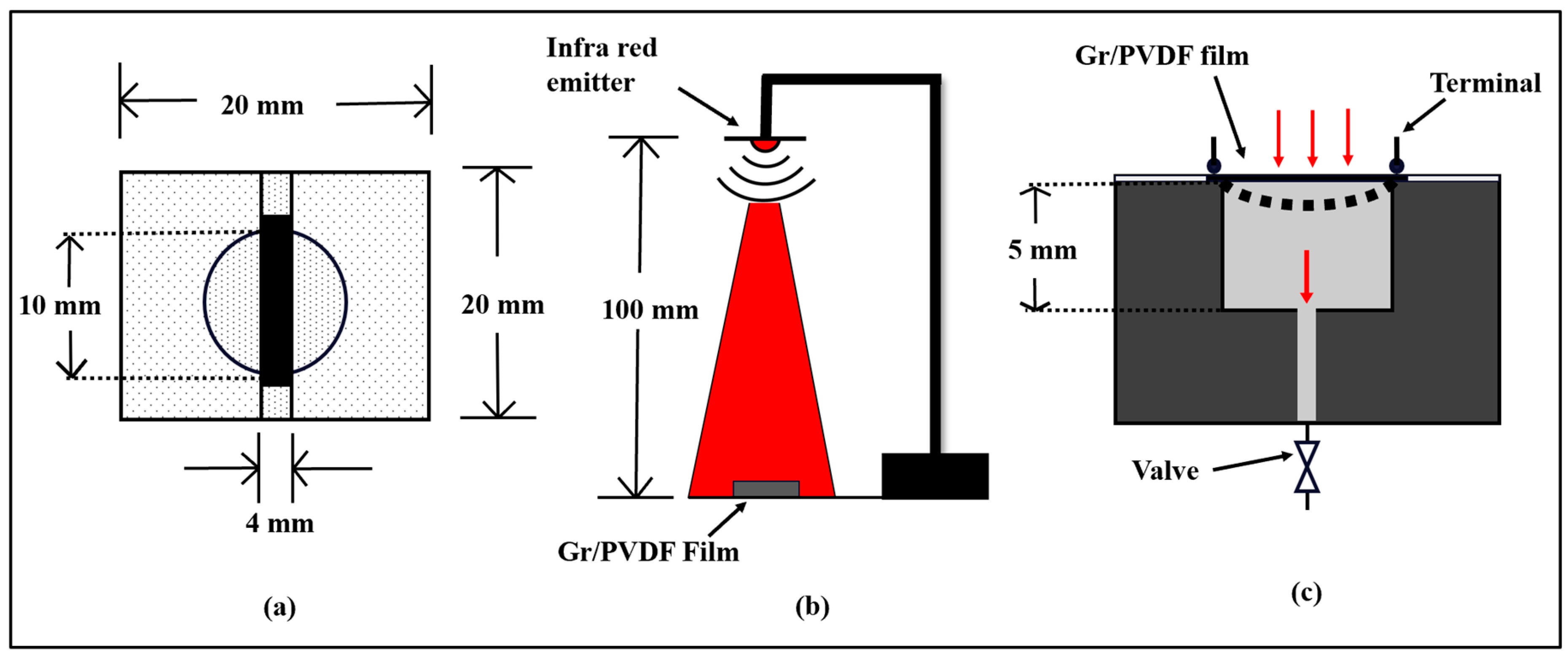
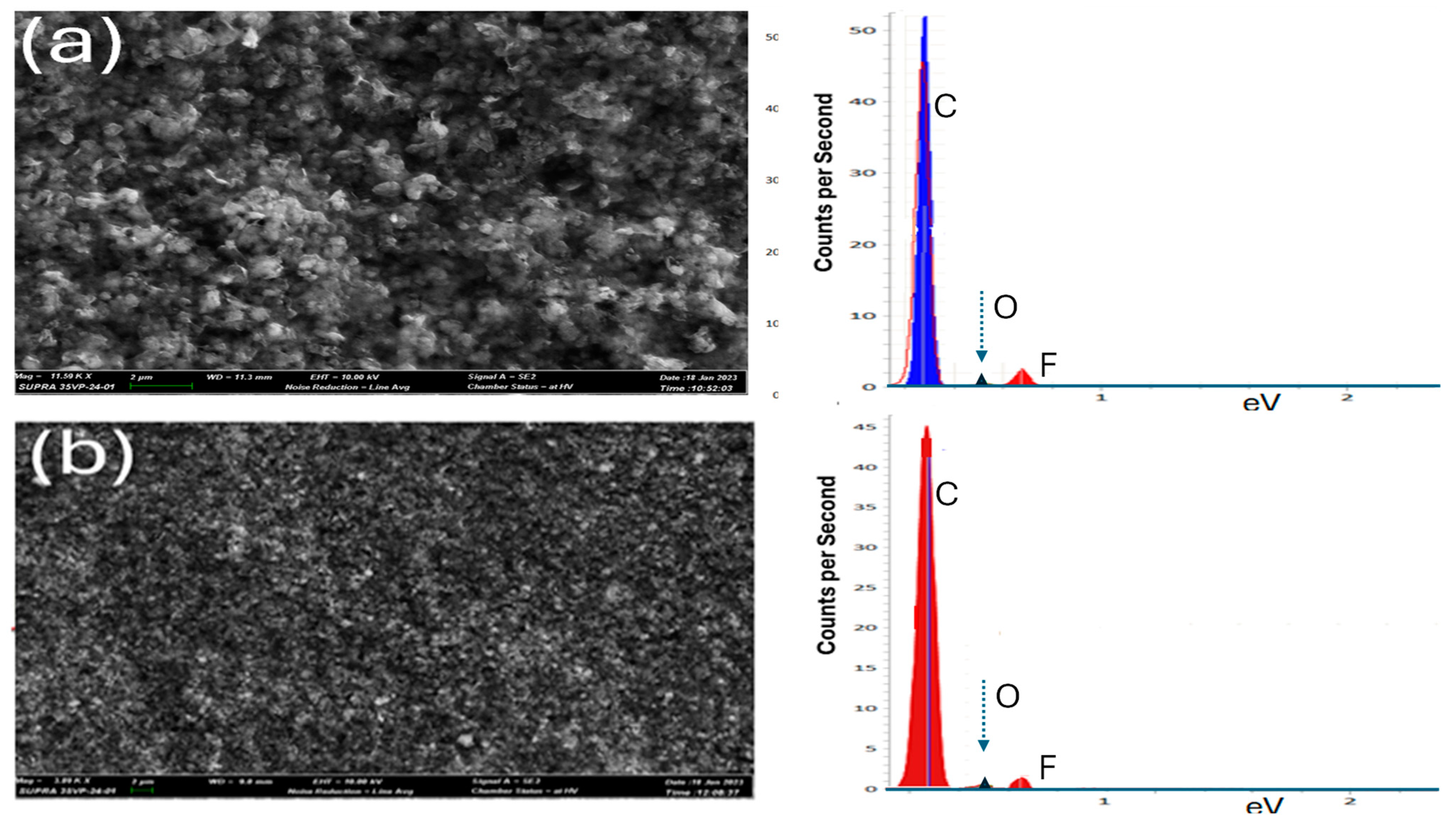
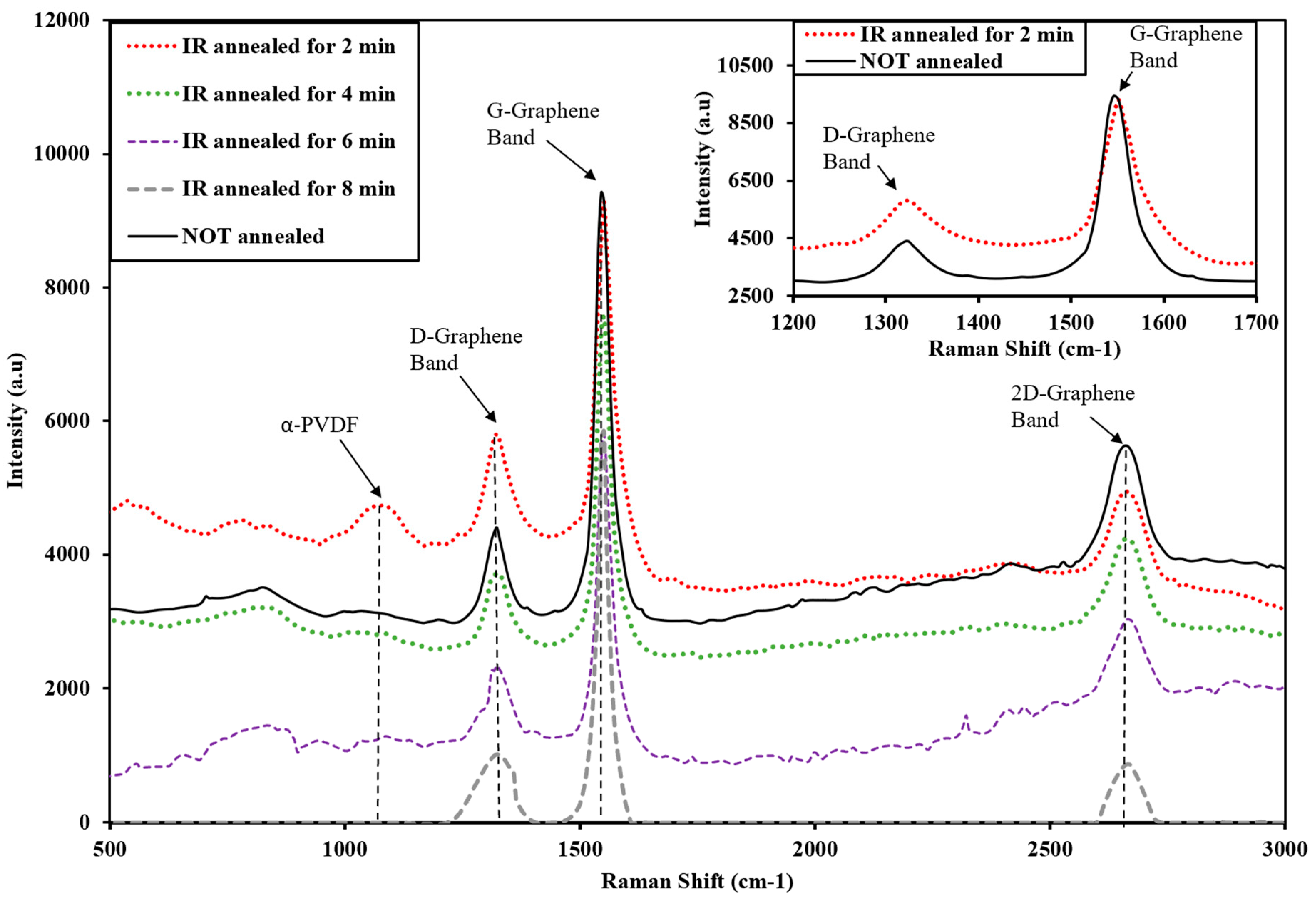
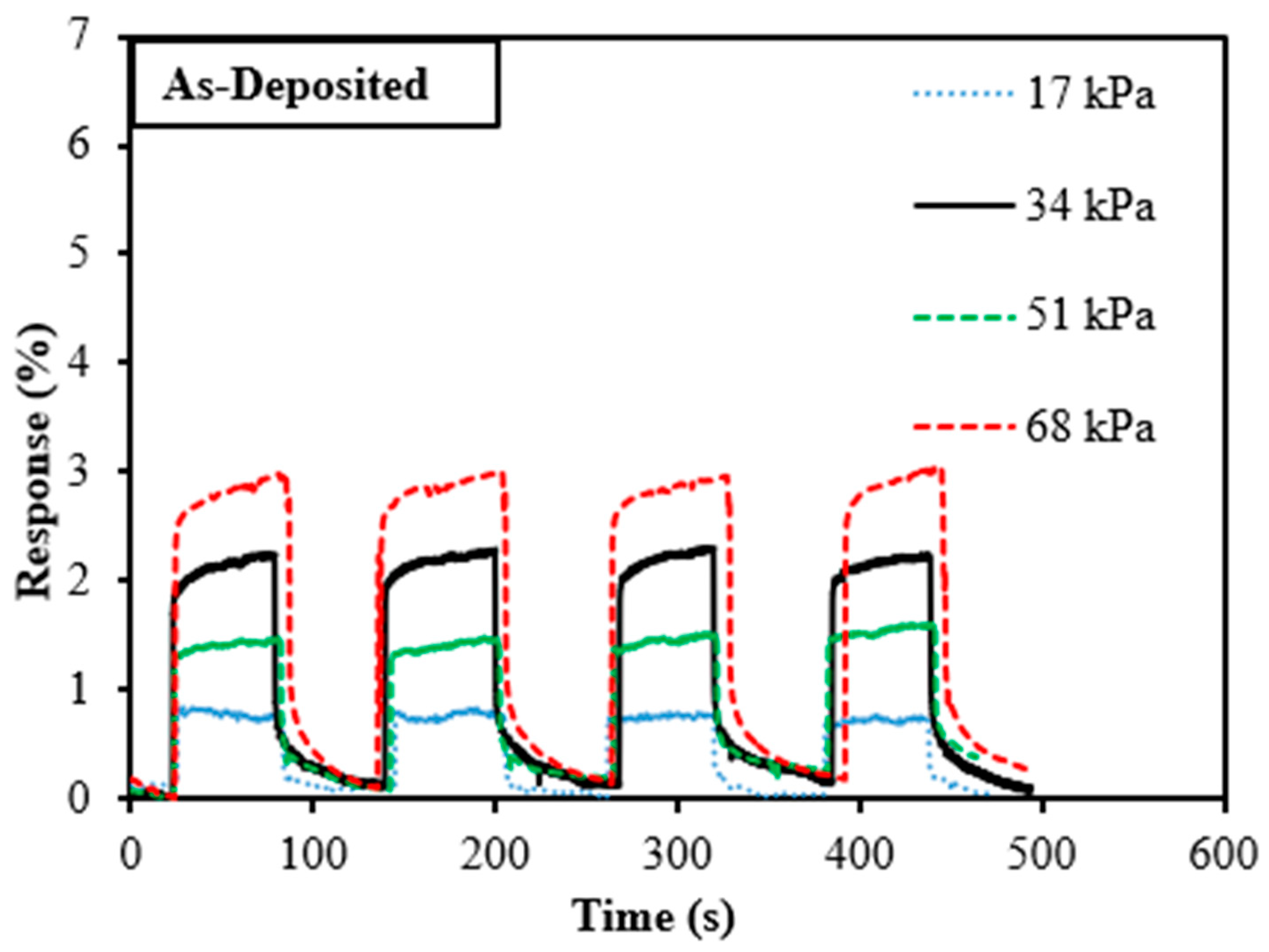
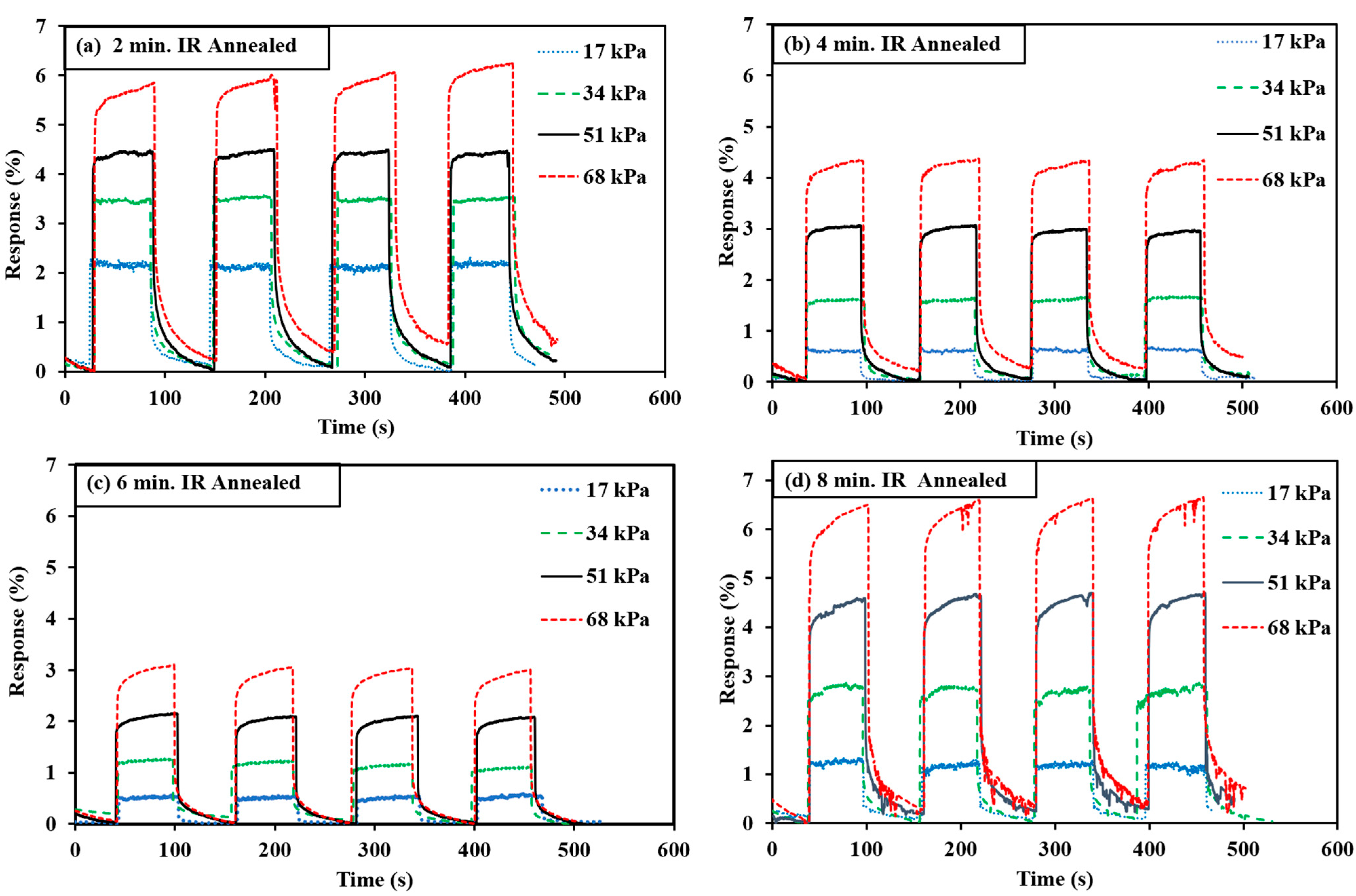

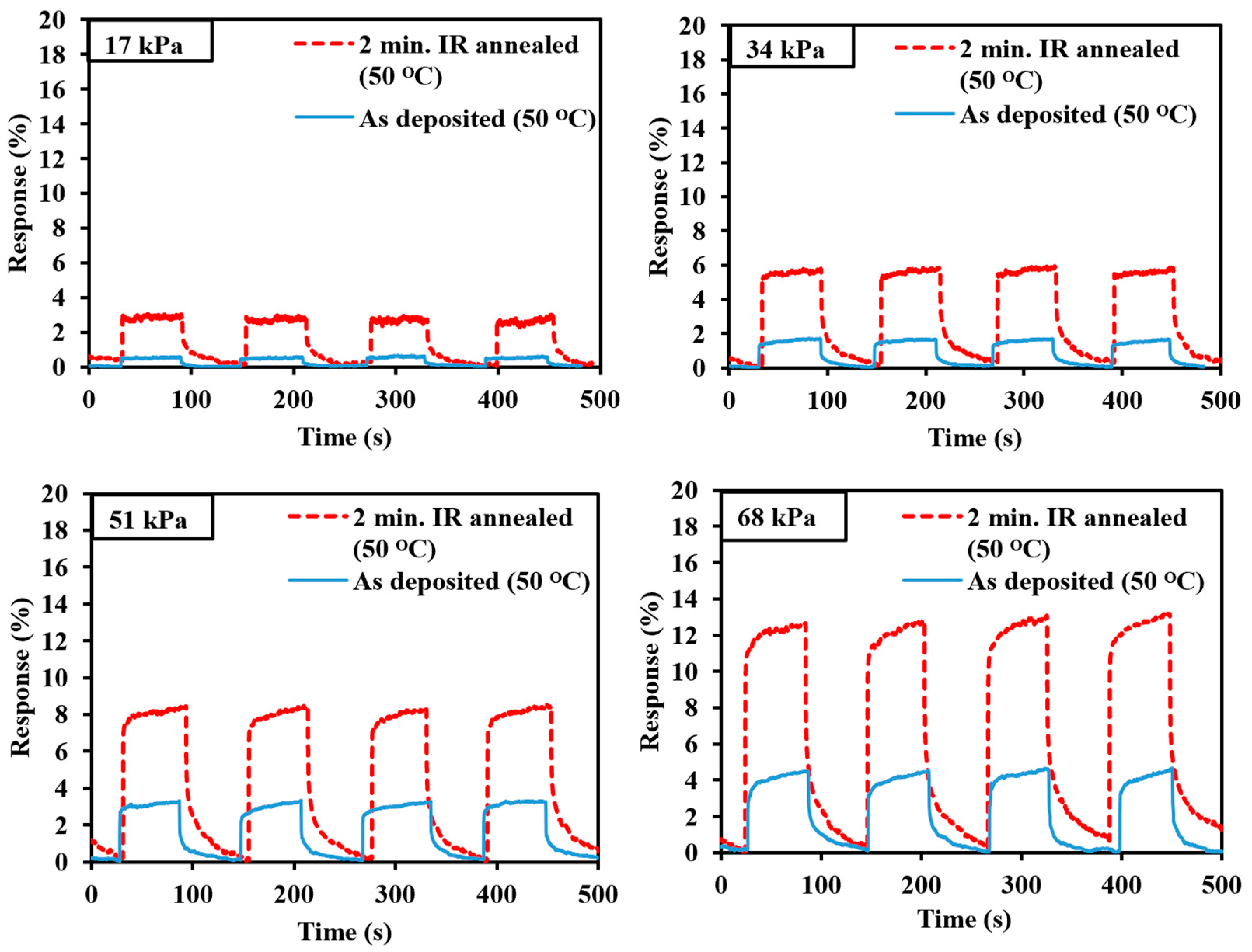

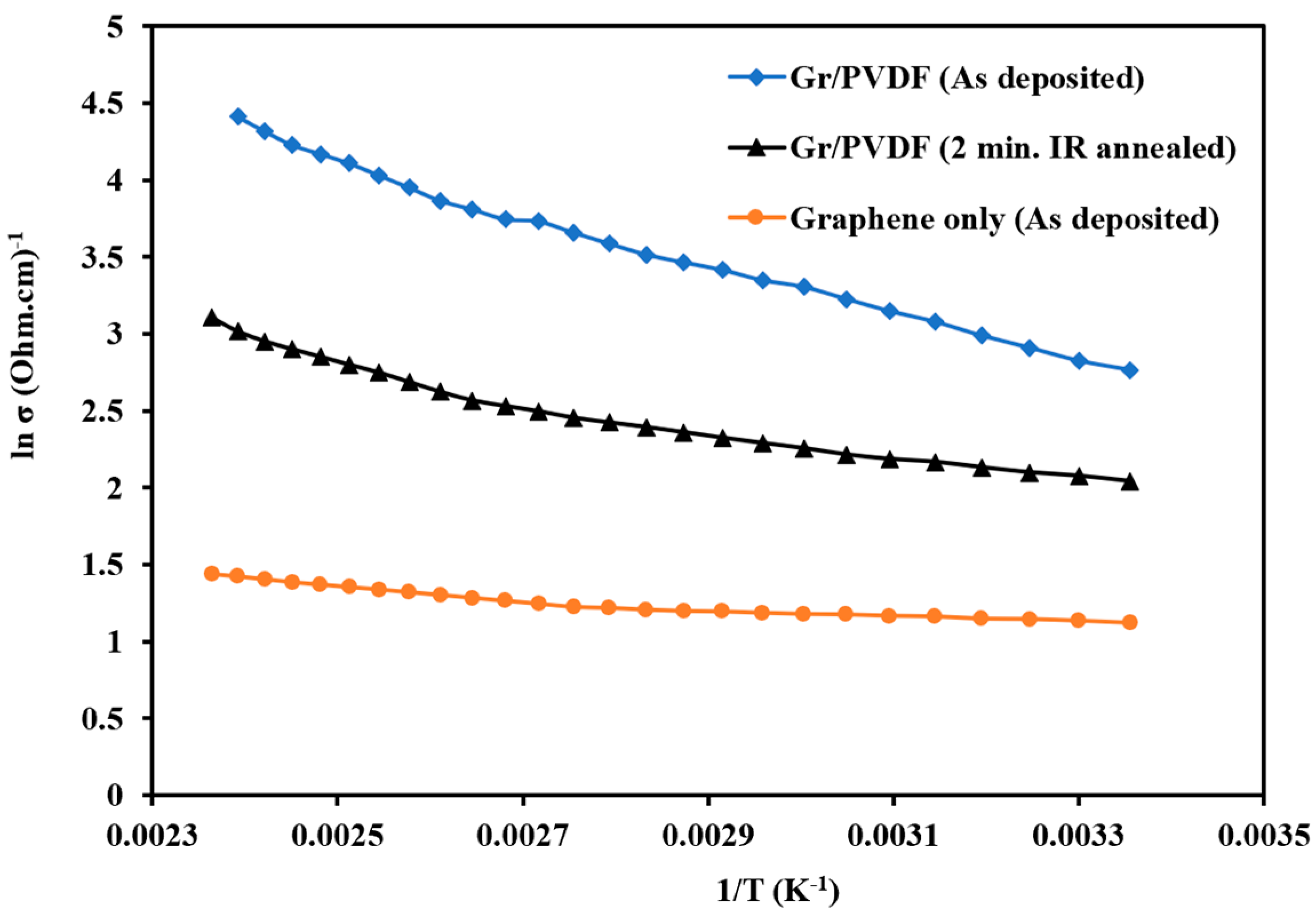

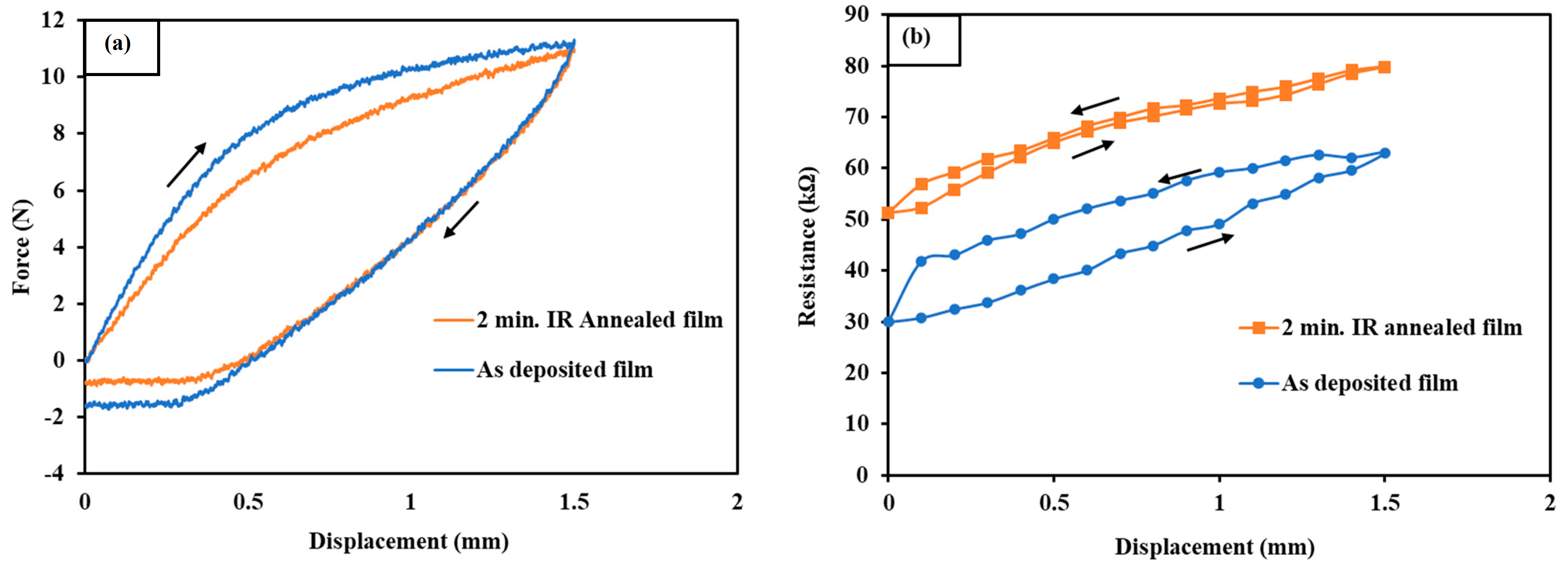
| Composites | Fabrication Methods | Applications | Ref. |
|---|---|---|---|
| Graphene/PVDF | Mixing technique with different co-solvent mixtures (acetone, THF, water, and EtOH) | Piezoelectric nanogenerator composite films | [16] |
| Electrospun PVDF/Graphene Membrane | Solution mixing technique | Humidity sensor | [17] |
| PVDF/Reduced Graphene Oxides (rGO) composite | Hydrothermal method and simple mixing technique | Flexible pressure sensors (improved sensitivity by 333.46% at 5 kPa, compared with individual PVDF composite rGO-titania TNL) | [18] |
| PVDF/Graphene | Prepared by gelation-induced crystallization of PVDF/cyclohexanone by varying the temperature and mixing time | Compressible sensors for sports and wearable electronics | [19] |
| Poly(vinylidene fluoride-hexafluoropropylene) (PVDF-HFP)/graphene | Gelation method | Water-repellent catalyst-supporting materials | [20] |
| GO-PVDF | Non-solvent-induced phase separation method | Nerve tissue engineering | [21] |
| (PVDF) with zero-dimensional super fullerene (SF), one-dimensional carbon nanotubes (CNT), and two-dimensional graphene sheets (GS) | Solution mixing followed by hot pressing | Advanced thermal management | [22] |
| Graphene/Polyvinylidene Fluoride | solution-phase mixing technique and dip-coating method | Knittle pressure sensor | [6] |
| Graphene/Polyvinylidene Fluoride | solution-phase mixing technique | Accelerometer for detection of low vibrations and airflow sensor | [10,23] |
| Material | Youngs Modulus | Electrical Conductivity | Activation Energy (Ea) | Pressure Sensitivity | Ref. |
|---|---|---|---|---|---|
| Graphene | 1000 ± 100 GPa | 104–106 S/cm | – | – | [42,43] |
| PVDF | 2.5–3.2 GPa | 10–11–10–8 S/cm | – | – | [44,45] |
| As-deposited Gr/PVDF | 10.2 GPa | 1.23 S/cm | 0.03 eV/K | 0.047 | (This work) |
| 2 min IR-annealed Gr/PVDF | 27.1 GPa | 2.48 S/cm | 0.14 eV/K | 0.072 | (This work) |
Disclaimer/Publisher’s Note: The statements, opinions and data contained in all publications are solely those of the individual author(s) and contributor(s) and not of MDPI and/or the editor(s). MDPI and/or the editor(s) disclaim responsibility for any injury to people or property resulting from any ideas, methods, instructions or products referred to in the content. |
© 2024 by the authors. Licensee MDPI, Basel, Switzerland. This article is an open access article distributed under the terms and conditions of the Creative Commons Attribution (CC BY) license (https://creativecommons.org/licenses/by/4.0/).
Share and Cite
Samoei, V.K.; Takeda, K.; Sano, K.; Bharadwaz, A.; Jayasuriya, A.C.; Jayatissa, A.H. Infrared Light Annealing Effect on Pressure Sensor Fabrication Using Graphene/Polyvinylidene Fluoride Nanocomposite. Inorganics 2024, 12, 228. https://doi.org/10.3390/inorganics12080228
Samoei VK, Takeda K, Sano K, Bharadwaz A, Jayasuriya AC, Jayatissa AH. Infrared Light Annealing Effect on Pressure Sensor Fabrication Using Graphene/Polyvinylidene Fluoride Nanocomposite. Inorganics. 2024; 12(8):228. https://doi.org/10.3390/inorganics12080228
Chicago/Turabian StyleSamoei, Victor K., Katsuhiko Takeda, Keiichiro Sano, Angshuman Bharadwaz, Ambalangodage C. Jayasuriya, and Ahalapitiya H. Jayatissa. 2024. "Infrared Light Annealing Effect on Pressure Sensor Fabrication Using Graphene/Polyvinylidene Fluoride Nanocomposite" Inorganics 12, no. 8: 228. https://doi.org/10.3390/inorganics12080228
APA StyleSamoei, V. K., Takeda, K., Sano, K., Bharadwaz, A., Jayasuriya, A. C., & Jayatissa, A. H. (2024). Infrared Light Annealing Effect on Pressure Sensor Fabrication Using Graphene/Polyvinylidene Fluoride Nanocomposite. Inorganics, 12(8), 228. https://doi.org/10.3390/inorganics12080228







